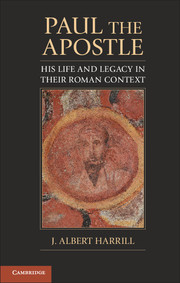Book contents
- Frontmatter
- Contents
- Figures and Boxes
- Preface
- Introduction
- PART I The Life
- PART II The Legend
- 4 Competing Stories about Paul in Late Antiquity
- 5 Paul the Scriptural Authority
- 6 How the West Got Paul Wrong
- Conclusion: Going beyond the Epitaph
- Appendix 1: Extant Writings Attributed to Saint Paul in Rough Chronological Order
- Appendix 2: Reconstructing Paul's Corinthian Correspondence: A Puzzle
- Appendix 3: Ancient Christian Works Containing Pauline Traditions and Legends
- Notes and Further Reading
- Bibliography
- Index of Biblical Citations
- Index
Conclusion: Going beyond the Epitaph
Published online by Cambridge University Press: 05 November 2012
- Frontmatter
- Contents
- Figures and Boxes
- Preface
- Introduction
- PART I The Life
- PART II The Legend
- 4 Competing Stories about Paul in Late Antiquity
- 5 Paul the Scriptural Authority
- 6 How the West Got Paul Wrong
- Conclusion: Going beyond the Epitaph
- Appendix 1: Extant Writings Attributed to Saint Paul in Rough Chronological Order
- Appendix 2: Reconstructing Paul's Corinthian Correspondence: A Puzzle
- Appendix 3: Ancient Christian Works Containing Pauline Traditions and Legends
- Notes and Further Reading
- Bibliography
- Index of Biblical Citations
- Index
Summary
A traditional biography would end with an account of the subject's death, which might also describe the gravesite or quote the tombstone's epitaph to find closure. But such a conventional conclusion poses several problems. First, it implies a false ordering of events, namely, that the biographical text is somehow coterminous with the life. A biography is not the same as the subject's actual life. Second, contemporary historians do not know where or how Paul died, nor whether his remains survive (see Chapter 2). How do we tackle these problems? As the Introduction explained, my historical solution has been to take up the form of antibiography and study many different Pauls. In that goal, let's find not one but several epitaphs.
The traditional epitaph of Paul is located at the ancient (and modern) pilgrimage site of the apostle's legendary tomb. On June 29, 2009, in Rome and broadcast live on Italian television, an emotional Pope Benedict XVI announced that carbon dating of the bones inside the marble sarcophagus under Rome's second largest basilica, Saint Paul Outside-the-Walls (Italian Basilica Papale di San Paolo fuori le mura), “seems to confirm the unanimous and uncontested tradition that they are the mortal remains of the Apostle Paul.” The announcement was a bombshell, and a carefully orchestrated papal performance – it came in a homily on the successful closure of a pastoral effort to celebrate the “Year of St. Paul” worldwide for Roman Catholics in the name of all Christians. Six years previously, Vatican archaeologists had, under the pavement of the basilica, unearthed the sarcophagus, which dates from the reign of the fourth-century emperor Theodosius I and bears the epitaph “Apostle Paul, Martyr” (Latin Paulo apostolo mart). Vatican authorities had declared, “At last, today pilgrims visiting the basilica can see the side of the sarcophagus through a small window we left open under the papal altar.” The epitaph points to an important theme that I have explained in the second part of this book – that Christians in late antiquity mostly viewed Paul as a martyr, not as the paradigmatic “sinner.”
- Type
- Chapter
- Information
- Paul the ApostleHis Life and Legacy in their Roman Context, pp. 163 - 166Publisher: Cambridge University PressPrint publication year: 2012



